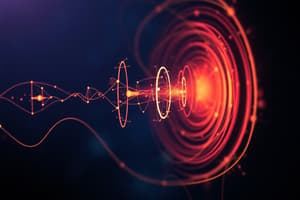Podcast
Questions and Answers
What is sound?
What is sound?
- A form of mechanical energy
- A form of energy producing sensation of hearing (correct)
- A form of light energy
- A form of heat energy
According to conservation of energy, what can be done with energy?
According to conservation of energy, what can be done with energy?
- Neither create nor destroy, only change forms (correct)
- Create but not destroy
- Change forms without limits
- Create and destroy at will
How is sound produced?
How is sound produced?
- By touching a table tennis ball gently
- By clapping hands
- By setting a tuning fork vibrating (correct)
- By suspending a plastic ball from a thread
What happens when a vibrating tuning fork touches a suspended table tennis ball?
What happens when a vibrating tuning fork touches a suspended table tennis ball?
What does conservation of energy imply about sound production?
What does conservation of energy imply about sound production?
What are the various sources of sound mentioned in the text?
What are the various sources of sound mentioned in the text?
What is sound and how is it related to energy?
What is sound and how is it related to energy?
What is the principle of conservation of energy and how does it relate to the production of sound?
What is the principle of conservation of energy and how does it relate to the production of sound?
Can sound be produced without utilizing energy? Explain.
Can sound be produced without utilizing energy? Explain.
Describe an activity mentioned in the text to demonstrate the production and transmission of sound. What are the observations and discussions related to this activity?
Describe an activity mentioned in the text to demonstrate the production and transmission of sound. What are the observations and discussions related to this activity?
Flashcards are hidden until you start studying
Study Notes
Sound and Energy
- Sound is a form of energy that is produced by vibrations or oscillations.
- According to the principle of conservation of energy, energy cannot be created or destroyed, only converted from one form to another.
Production of Sound
- Sound is produced when an object vibrates, causing the air particles around it to oscillate and transfer energy through the air as a pressure wave.
Vibrating Tuning Fork Experiment
- When a vibrating tuning fork touches a suspended table tennis ball, the vibration is transferred to the ball, causing it to oscillate and producing sound.
- This demonstrates the transfer of energy from the tuning fork to the ball, producing sound.
Conservation of Energy and Sound Production
- The principle of conservation of energy implies that sound production requires energy, and that energy is converted from one form to another during the production and transmission of sound.
- Sound cannot be produced without utilizing energy.
Sources of Sound
- Various sources of sound mentioned in the text include vibrating objects, such as tuning forks.
Activity: Demonstrating Sound Production and Transmission
- The activity mentioned in the text involves using a vibrating tuning fork to produce sound and demonstrating its transmission through the air to a suspended table tennis ball.
- Observations and discussions related to this activity include the transfer of energy from the tuning fork to the ball, producing sound, and the demonstration of the principle of conservation of energy.
Studying That Suits You
Use AI to generate personalized quizzes and flashcards to suit your learning preferences.




